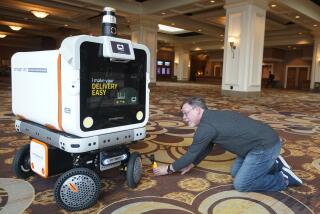On display: TV advances that are a little remote
LAS VEGAS — The latest in television technology is on display at the annual Consumer Electronics Show, with super-thin screens, three-dimensional imagery, wireless connections and ultra-sharp picture quality.
Too bad you can’t afford it.
All of this state-of-the-art TV tech -- much of it not yet available -- is extremely expensive, which is even more of a consideration for buyers in these recessionary times.
But it’s fun to dream. Besides, prices for new consumer electronics products almost always plunge when (and if) the products become popular.
Only four years ago, a 46-inch LCD TV -- then considered exotic -- retailed for about $10,000. Now you can pick one up for about $1,000.
By the time this year’s new products get down to an Earthly level, perhaps the economy will be bouncing back.
Here’s a sampling of the new TV technologies on exhibit.
3-D display: There’s been lots of talk about 3-D for TV. But it was Panasonic that stole the thunder with the first presentation outside Japan of its proprietary system, meant for movie theaters as well as TV.
And how did it look?
Fantastic. The several clips shown from movies and live-action events, including sequences from the opening ceremonies of the Olympic Games in Beijing, had extraordinary depth and brightness.
But they were shown under ideal conditions, in a darkened room on a 103-inch plasma screen. And the basic hurdle of home 3-D remains: the glasses that transform the blurry images on the screen to 3-D. Every time you’d head to the kitchen for a snack, turn to a friend to chat or do any other activity apart from watching the program, you’d have to take off the glasses to see the real world.
Also, there could be a physical problem. After the showing that lasted about 10 minutes, some viewers reported eyestrain and a tinge of nausea.
Battling the blur: If Santa just brought you an LCD television with a 120Hz refresh rate -- which eliminates much of the blur in fast-action sequences on standard 60Hz LCD televisions -- you’re already passe.
Sony, which introduced a 240Hz set in the fall, debuted nine models at CES with that refresh rate. No pricing was giving for the new sets due out in the spring, but the current 52-inch Sony model with 240Hz lists for more than $4,000.
Even that refresh rate was put to shame by LG Display, which demonstrated a 480Hz monitor. It looked extremely sharp on an action sequence from the movie “Transformers,” but it was impossible to tell without a side-by-side comparison just how much better it was than a 240Hz or even 120Hz display.
Wireless: Flat-panel HDTVs look great mounted on the wall, but the hookup wires and power cord pose problems. They have to be hidden in the wall (which requires the help of an installer unless you’re especially handy) or left to hang loose.
At CES, a few manufacturers said they would be making wireless systems robust enough to handle high-definition signals. Panasonic said they would be worked into its Z1 line due out this year. Marketing executive Bob Perry didn’t get into specifics of how far the signal would carry from a control unit to a screen but said it would be a “same-room” technology.
No pricing for Z1 sets was disclosed.
Thin is in: Although the trend is against ultra-thinness in people, in TVs the race continues to produce skinnier TVs, partly because they often go hand in hand with energy savings.
Several companies, including LG Electronics and Samsung, announced new lines of LED-backlighted LCD sets, which are not only thinner and require less power but also don’t use mercury, which can be harmful if it ends up in landfills.
One of the most impressive demonstrations of thinness was a Panasonic plasma prototype less than a third of an inch thick. But the company said it wouldn’t be ready for the marketplace until at least 2010.
Satellite TV on the road: Satellite TV in cars has been pretty much a disaster so far, with the picture and sound freezing every time so much as a light pole blocks the signal. To duplicate the effect at home, hit the pause button randomly on your TiVo about 20 times a minute.
A new system by AT&T; CruiseCast, though not perfect, is a huge improvement. During a ride in a test vehicle at CES, the CruiseCast system managed to play live cable channels almost seamlessly while riding through Las Vegas neighborhoods.
The system uses a buffer regimen to keep the channel playing even when momentarily blocked.
“As long as we can get a signal 1 1/2 minutes out of every three, it will keep going,” said Winston Guillory, president of RaySat Broadcasting, which has partnered with AT&T; on the system.
But then the van headed down the Strip, with its tall buildings. Several times along the way, the image from MSNBC froze, especially when the van was stuck in traffic.
The system, due to hit the market in March, will cost about $1,300 for the equipment (not including the TV monitors) and then $28 a month for the TV service.
TV on your shirt: Sure, you can watch videos on some cellphones, but the picture is minuscule.
Now comes a solution. At CES, Samsung and Texas Instruments debuted the first cellphone with a tiny video projector hidden inside. It can shine whatever is on the screen onto a wall, the back of a notebook or even a friend’s shirt.
It can show photos, slides, movies and live TV if your phone is set up for that.
The projector, which uses the same Texas Instruments technology as big-screen DLP TVs, produces a perfectly watchable image. But the first phone to use it, by Samsung, will be available only in South Korea later this month.
Here in the U.S., we’ll have to wait to show “SpongeBob SquarePants” on an actual pair of pants.
--

